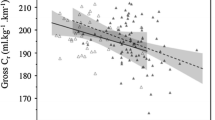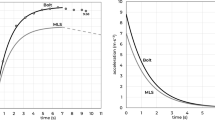Summary
A major criticism of present models of the energetics and mechanics of sprint running concerns the application of estimates of parameters which seem to be adapted from measurements of running during actual competitions. This study presents a model which does not perpetuate this solecism. Using data obtained during supra-maximal cycle ergometer tests of highly trained athletes, the kinetics of the anaerobic and aerobic pathways were modelled. Internal power wasted in the acceleration and deceleration of body limbs and the power necessary to overcome air friction was calculated from data in the literature. Assuming a mechanical efficiency as found during submaximal cycling, a power equation was constructed which also included the power necessary to accelerate the body at the start of movement. The differential equation thus obtained was solved through simulation. The model appeared to predict realistic times at 100 m (10.47 s), 200 m (19.63 s) and 400 m (42.99 s) distances. By comparison with other methods it is argued that power equations of locomotion should include the concept of mechanical efficiency.
Similar content being viewed by others
References
Aleshinsky SY (1986) An energy “sources” and “fractions” approach to the mechanical energy expenditure problem I–V. J Biomech 19:287–315
Behncke H (1987) Optimization models for the force and energy in competitive sports. Math Methods Appl Sci 9:298–311
Boileau RA, Maghew JL, Riner WF, Lussier L (1982) Physiological characteristics of elite middle and long distance runners. Can J Appl Sport Sci 7:167–172
Dapena J, Feltner ME (1987) Effects of wind and altitude on the times of 100 meter sprint races. I.J.S.B. 3:6–39
Davies CTM (1980) Effects of wind assistance and resistance on the forward motion of a runner. J Appl Physiol 48:702–709
Di Prampero PE (1981) Energetics of muscular exercise. Rev Physiol Biochem Pharmacol 89:143–222
Fenn WO (1930) Frictional and kinetic factors in the work of sprint running. Am J Physiol 92:583–611
Fukanaga T, Matsuo A (1981) Mechanical energy output and joint movements in sprint running. Ergonomics 24:765–772
Furusawa K, Hill AV, Parkinson JL (1927) The dynamics of sprint running. Proc R Soc 102 B:713–720
Haan A de, van Ingen Schenau GJ, Ettema GJ, Huijing PA, Lodder MAN (1989) Efficiency of rat medial gastrocnemius muscles in contractions with and without an active prestretch. J Exp Biol 141:327–341
Henry FM (1954) Time-velocity equations and oxygen requirements of “all-out” and “steady-pace” running. Res Q 25:164–177
Henry FM (1955) Prediction of world records in running sixty yards to twenty-six miles. Res Q 26:147–158
Henry FM, Trafton IR (1951) The velocity curve in sprint running. Res Q 22:409–422
Hill AV (1927) Muscular movement in man: the factors governing speed and recovery from fatigue. McGraw-Hill, New York
Ikai M (1968) Biomechanics of sprint running with respect to the speed curve. Biomechanics I. Karger, Basle, pp 282–290
Ingen Schenau GJ van (1982) The influence of air friction in speed skating. J Biomech 15:449–458
Ingen Schenau GJ van, Cavanagh PR (1990) Power equations in endurance sports (survey). J Biomech 23:865–881
Ingen Schenau GJ van, Hollander AP (1987) Comment on ‘A mathematical theory of running’ and the application of this theory. J Biomech 20:91–95
Ingen Schenau GJ van, Boer RW de, Geysel JSM, de Groot G (1988) Supra-maximal tests in evaluating physical condition of male and female athletes. Eur J Physiol 57:6–9
Ingen Schenau GJ van, Koning JJ de, de Groot G (1990) A simulation of speed skating performances based on an equation of power production and power dissipation. Med Sci Sports Exerc 22:718–728
Katch VL (1973) Kinetics of oxygen uptake and recovery for supra maximal work of short duration. Int Z Angew Physiol 31:197–201
Keller JB (1973) A theory of competitive running. Physics Today 26:43–47
Kyle CR (1979) Reduction of wind resistance and power output of racing cyclists and runners traveling in groups. Ergonomics 22:387–397
Kyle CR, Caiozzo VJ (1986) The effect of athletic clothing aerodynamics upon running speed. Med Sci Sports Exerc 18:509–515
Kyle CF, Wapert RA (1989) The wind resistance of the human figure in sports. Proceedings First IOC World Congress on Sport Sciences, US Olympic Committee, Colorado Springs, p 287
Lloyd BB (1966) The energetics of running: an analysis of world records. Adv Sci 22:515–530
Lloyd BB, Zacks RM (1972) The mechanical efficiency of treadmill running against a horizontal impeding force. J Physiol 223:355–363
Mader A, Heck H, Liesen H, Hollmann W (1983) Simulative Berechnungen der dynamischen Änderungen von Phosphorylierungspotential, Laktatbildung und Laktatverteilung beim Sprint. Dtsch Z Sportmed 1:14–22
Margaria R (1976) Biomechanics and energetics of muscular exercise. Clarendon Press, Oxford
Morton RH (1985) Mathematical representation of the velocity curve of sprint running. Can J Appl Sport Sci 10:166–170
Peronnet F, Thibault G (1989) Mathematical analysis of running performance and world running records. J Appl Physiol 67:453–465
Pugh LGCE (1976) Air resistance in sport. Medicine sport vol. 9. Advances in exercise physiology. Karger, Basle, pp 149–164
Vaughan CL, Matravers DR (1977) A biomechanical model of the sprinter. J Human Mov Stud 3:207–213
Volkov NI, Lapin VI (1979) Analysis of the velocity curve in sprint running. Med Sci Sports 11:332–337
Ward-Smith AJ (1985) A mathematical theory of running, based on the first law of thermodynamics, and its application to the performance of world class athletes. J Biomech 18:337–349
Williams KR, Cavanagh PR (1983) A model for the calculation of mechanical power during distance running. J Biomech 16:115–128
Zacks RM (1973) The mechanical efficiencies of running and bicycling against a horizontal impeding force. Int Z Angew Physiol 31:249–258
Author information
Authors and Affiliations
Rights and permissions
About this article
Cite this article
van Ingen Schenau, G.J., Jacobs, R. & de Koning, J.J. Can cycle power predict sprint running performance?. Eur J Appl Physiol 63, 255–260 (1991). https://doi.org/10.1007/BF00233857
Accepted:
Issue Date:
DOI: https://doi.org/10.1007/BF00233857




